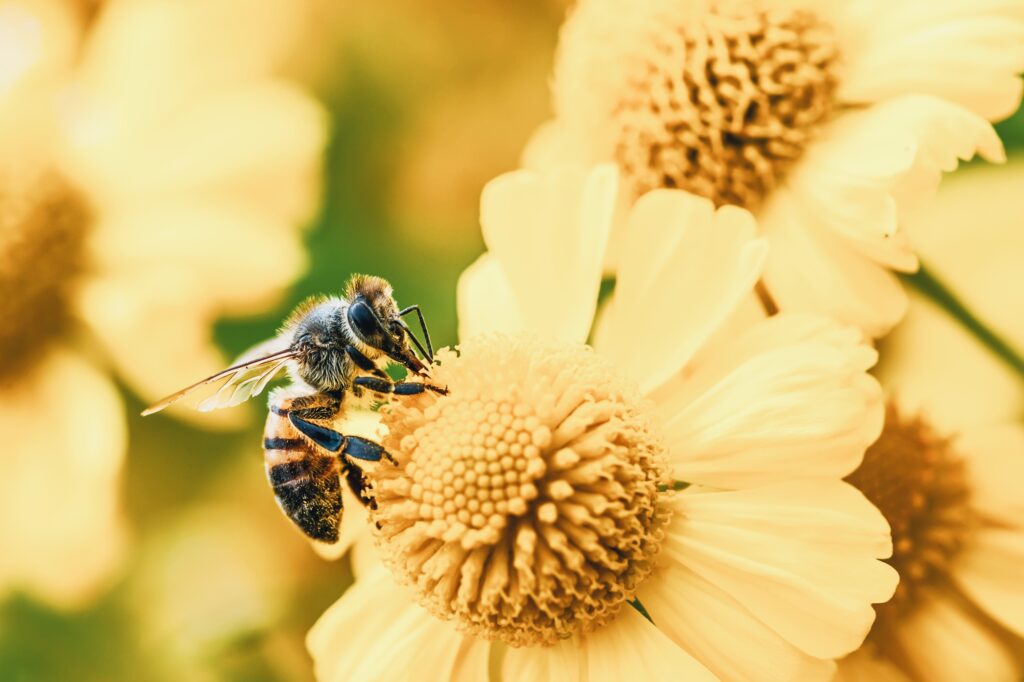The city of Utrecht, Netherlands is saving bees with a huge insect hotel.
The project consists of more than 200 individual nesting boxes for wild bees and other essential pollinators. The bee homes cover a 28 meter-high billboard tower on the side of the A2 motorway — one of the busiest highways in the country.
Because wild bees search for pollen and nectar within 200 meters of their nesting site, the city of Utrecht also planted a 7,000 m2 meadow of wildflowers nearby, complete with sand and hills for native ground-nesting populations such as plasterer or “silk” bees.
Wildflower meadows provide a huge boost to pollinators of all kinds, and road and railway sidings in general have proven important breaks in pervasive agricultural landscapes. They offer unique and biodiverse ecosystem services to local wildlife and frequently make constructive use of previously underutilized space.
Around the world, increasing emphasis on rewilding efforts and urban greening presents a rare opportunity to promote environmental health in built up areas, such as Utrecht’s highway-adjacent insect habitat.
Media company Ocean Outdoor Nederland came up with the tower, while Honey Highway (an initiative transforming roadsides with bee-friendly plants and flowers) created the meadow. According to Gemeente Utrecht, the tower itself is made of recycled steel and uses energy efficient, automatic LED lights. Unemployed Utrechters built the nesting boxes.

What are bee stops?
The billboard project was finalized in 2020, just one year after the launch of 316 Dutch “bee-stops” — bus shelter roofs transformed with the addition of succulents and other plants. They are designed to capture dust, store rainwater, purify air, and of course, attract pollinators.
Much like the billboard tower, the hundreds of bee stops also feature energy efficient LED lighting as well as bamboo benches. The rooftop gardens are tended by workers who drive electric vehicles for the region’s increasingly electrified public transport system.
National greening efforts such as this — as well as broader emissions and sustainability goals — are twofold. They simultaneously encourage the Netherlands’ waning bee population and help to reduce the country’s chronic pollution. (As per the World Health Organization’s guidelines, the air quality in the Netherlands is considered moderately unsafe).
Today, more than 50 percent of the country’s 360 bee species are endangered. The wild bee population of the Netherlands has declined steadily for the last 80 or so years, due in part to industrial agriculture, monoculture farming, and harsh pesticides.
Across Europe, the bumblebee population fell by a significant 17 percent between 2000 and 2014 alone. Both national and global analysis of bee populations also report that human-kept honeybees may be competing with wild varieties for food sources.
“Bees are struggling,” writes the city council. “Utrecht has over 100 species of bees, including rare species. The bee hotel and wildflower meadow will help protect the bees. Bees are essential to the continued existence of many plants.”
Despite the Netherlands’ long-term struggle to maintain its bee population, the most recent edition of the National Bee Census reported that there has been no strong decline in Dutch urban gardens.
The Netherlands’ bee-saving efforts are working
Over 11,000 people took part in the census, each spending 30 minutes in their respective outside spaces recording the varieties and numbers of bees present. As of April 18, 2021, enthusiastic volunteers counted over 200,000 bees and hoverflies.
This welcome plateauing of the bee population is perhaps due to the country’s continued efforts to preserve the essential species. However, the National bee Census will collect at least five years of data (2021 is the fourth edition) before definitively mapping the growth or shrinkage of Dutch bee numbers.
Banning pesticides is one key way for national governments to protect these populations, and in 2020 the European Commission committed to reducing the use of chemical pesticides by 50 percent by 2030. This legislation is part of the EU’s “Green Deal,” which specifically states the goal of reversing population decline in bees and other pollinators.
Back in 2018, the EU banned all outdoor use of the three main neonicotinoid insecticides — clothianidin, imidacloprid, and thiamethoxam. All of which can cause impairment of movement and memory in bees, as well as death.
While the UK government briefly authorized the emergency use of thiamethoxam earlier this year, the move prompted extensive backlash (and legal threats) from environmentalists, scientists, and activists. The government abandoned the plan shortly thereafter.
The U.S. passed a ban on similar pesticides in 2019, and the Environmental Protection Agency (EPA) prohibited the use of 12 different products containing neonicotinoids. The EPA has incorporated pollinator protection at all its facilities, on its website, and as part of other programs.
It also launched the Pollinator Protection Initiative to assess and promote pollinator habitats and communities. The initiative inventories flora types, observes and identifies pollinator species, and reviews landscaping practices.

Why are bees important?
Former Food and Agriculture Organization (FAO) Director-General José Graziano da Silva wrote in a statement about the impact of declining bee populations on global food security.
He said: “Bees are under great threat from the combined effects of climate change, intensive agriculture, pesticides use, biodiversity loss and pollution.”
Over 75 percent of the world’s food crops are dependent on pollinators such as bees, but in North America alone nearly one out of every four bees is at risk of extinction. The International Union for the Conservation of Nature (IUCN) reports declining populations throughout Europe, South America, and Asia.
But falling bee numbers isn’t just a problem for food security. The tiny pollinators are a keystone species, which means the entirety of the ecosystem is dependent on their continued presence and good health.
Even relatively small fluctuations in keystone species’ population can impact other species occupying the same space, and the extinction of bees would be absolutely catastrophic for plants, animals, humans, and the planet in general.
5 effective ways people are saving bees
Fortunately, there are several things people can do to support bee populations, including gardening, government lobbying, and adjusting shopping habits. Here are some of the ideas and initiatives saving bees — and some of the organizations working on them.

Converting outdoor spaces
As in Utrecht, outdoor spaces can be updated to encourage and support native bee populations. Organizations such as BeesMAX in the UK, Apis Arborea in the U.S., (and Honey Highway in the Netherlands) are working hard to rewild outdoor spaces for pollinators. While the Wildlife Trust’s 30-30-30 campaign aims to restore 30 percent of British land and sea by 2030.
James Byrne, Landscapes Recovery Programme Manager for The Wildlife Trusts, told LIVEKINDLY: “Connecting existing wildlife hotspots, restoring habitats, and making our landscapes wilder are all parts of a complex puzzle we desperately need to solve.”
“Bees, wasps, beetles and other pollinators are essential to a functioning ecosystem. Without them, we risk the collapse of the entire natural world,” he added.
There are also countless online guides to bee-friendly gardening, so that everyone can get involved in the creation of bee-friendly spaces. Whether you have access to a garden, yard, window box, roof, your local park, or even an abandoned lot, you can plant and encourage native flora for the benefit of pollinators
Choosing varieties that will provide year-round blooms also makes a difference, as does ditching pesticides. Opting for natural deterrents instead will help support bees and all other wildlife in your area, just like on a national scale.
“Gardens can be vital havens for wildlife and have potential to play a massive role in nature’s recovery,” said Byrne. “Letting the grass grow long, using only peat-free compost, planting nectar rich wildflowers, and ditching pesticides, fertilizers and herbicides are simple steps people can take to give bees and other insects a fighting chance.”
Building shelters
Building shelters is also something that various organizations and individuals are working on, and you can create your own or buy one ready-made. While it can feel like there is a lack of decisive national action from governments, it’s worth making a search of your area for one of the many community-led pollinator projects.
For example, in Lancaster, UK The Fairfield Association recently began assembling bee-friendly window boxes for locals without their own outdoor space, as reported by the Lancaster Guardian.
If you don’t have any outdoor space at all, you can still get involved in pollinator counts such as the National Bee Census in the Netherlands or the Great British Bee Count in the UK.
Lobbying
By lobbying local and national representatives on bee-related issues, organizations and individuals hope to force action from their governments.
International NGO Greenpeace suggests that there are three “common-sense” solutions to the falling global bee population, including the banning of pesticides, preservation of wild habitat, and restoration of ecological agriculture. These are all issues that various organizations are working to bring to world governments’ attention
“We also need to change how we farm as well,” confirmed Byrne. “That involves dramatically reducing chemicals, which are so damaging to pollinating insects, increasing field margins of wildflowers and other vegetation, and ensuring policies back farmers doing great work for wildlife.”
Diverse environmental groups such as Rewilding Britain, the Sustainable Agriculture Network, the World Bee Project, and Regeneration International are all also working on these or related issues to some extent.
Encouraging the planting of bee-friendly flowers and plants in public spaces, or renovating and otherwise using abandoned areas of land are both key topics to discuss with your representative, and this is something everyone can do from their own home via email.

Advocate for a honey-free diet
Many beekeepers also advocate for better protection of wild bees and other pollinators. But organizations such as the Vegan Society maintain that honey production and large-scale farming endangers bees further. This issue has also been widely covered by a diverse range of media outlets including NPR, Fast Company, the Guardian, and the Ecologist.
Farmed honey bees actually compete with other nectar-foraging pollinators, including wild and bumblebees, making their eventual extinction ever more likely. Additionally, some countries (including the UK) import the majority of their honey, which causes greenhouse gas emissions and particulate pollution that further endangers insects and other wildlife.
There are also a variety of practices common in industrial bee farming that are considered cruel. These include wing clipping, smoking, death during insemination, and gassing with cyanide — if the keeper decides they are too expensive to keep throughout the winter months.
Importantly, humans don’t need honey to survive, and there are a growing number of plant-based alternatives such as agave nectar, maple syrup, molasses, rice syrup, date syrup, and even home-made dandelion “honey.”
Buying local, seasonally produced and organic fruit and vegetables in general helps support pollinators thanks to the lack of pesticides and overall smaller environmental footprint.
Education and resources
Organizations ranging from the Bumblebee Conservation Trust to the EPA to Friends of the Earth have online resources about how to help pollinators in your area, with the latter even offering “Bee Saver Kits” and how-to guides for bee hotels.
Learning more about bees yourself (and spreading awareness to the other people in your life) can help encourage more sustainable gardening, shopping, and other day-to-day choices. “Often it’s as much about changing the mindset as it is about changing the garden,” Byrne told LIVEKINDLY.
For more tips on how to protect bees in your garden, check out our guide here.


